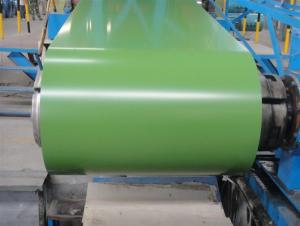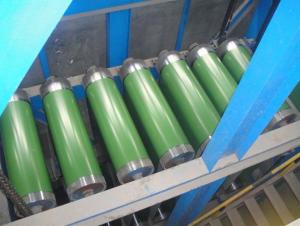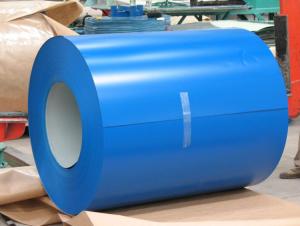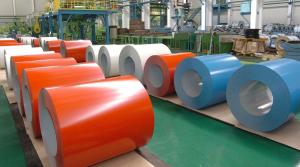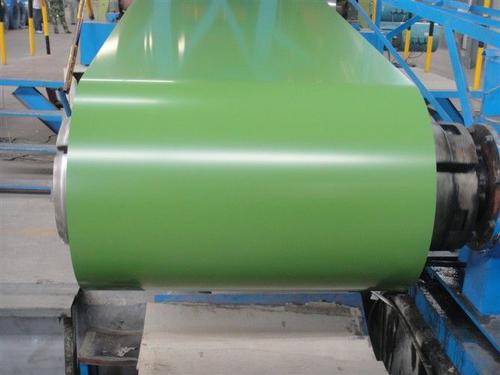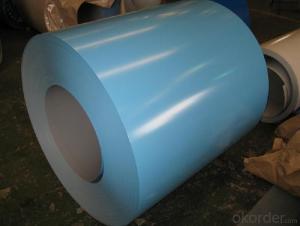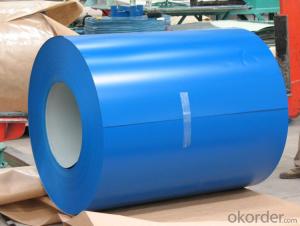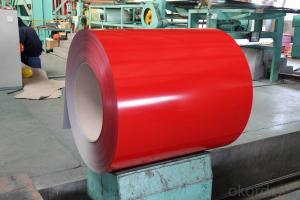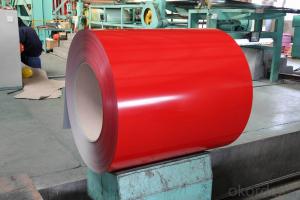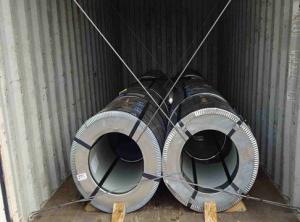Prepainted Gavanlume Steel Coils
- Loading Port:
- China Main Port
- Payment Terms:
- TT OR LC
- Min Order Qty:
- -
- Supply Capability:
- -
OKorder Service Pledge
OKorder Financial Service
You Might Also Like
Specifications
prepainted galvanized steel in coils
raw materials: HDGI or HDGL
Thickness Range: 0.17mm~1.0mm
Width Range: 1500mm below
color coated steel coil
1). Standards: JIS G3302, JIS G3312, ASTM A653M/A924M, CGCC, EN10143, ASTM A792
Material Grade: Hot dipped galvanized steel coil DX51D+Z EN10142
2). Thickness: 0.17~1.0mm. Thickness tolerance: +-0.02mm
Width: 600mm~1500mm; 762MM/914MM1000MM/1250MM/1500MM
3). Surface Treatment: Ral color or according to customer requirement, With or without protect film
Zinc coating: 50~275G/M2 color thickness: top side: 15~25um, back side:5~7um
4). Quality: No Joint, No Bends, no spots, no roller marks.
MTC will be provided with goods, third part inspection is acceptable, for example, SGS, BV. Etc
5). Coil ID: 508mm or 610mm
Coil Weight: 3~6MT as per client's requirement
7). Delivery: within 15~25 days since prepayment or L/C confirmed
8). Application: Widely used for roofs, outer walls, ovens, explosive-proof-steel, electrically controlled cabinets, and industrial freezers in the residential and industrial buildings,
household appliances, transportation, base plate, color coating, and so on
- Q: How are steel coils inspected for surface quality?
- Steel coils are inspected for surface quality through a meticulous process that involves various methods and technologies. The inspection is crucial as it ensures the coils meet the required standards and are free from any defects or imperfections. Here are the steps involved in inspecting steel coils for surface quality: 1. Visual Inspection: Initially, the coils undergo a visual inspection where trained personnel visually examine the entire surface for any visible defects such as scratches, dents, or any irregularities. This step helps identify any obvious issues that can be detected through visual observation. 2. Magnetic Particle Inspection: This non-destructive testing method involves applying a magnetic field to the steel coil's surface and then applying a magnetic particle solution. Any surface cracks or defects will cause the magnetic particles to cluster, making them visible under proper lighting. This technique is highly effective in detecting surface cracks and other surface abnormalities. 3. Eddy Current Testing: This method of inspection utilizes electromagnetic induction to identify surface defects. An eddy current probe is passed over the steel coil's surface, and any variations in the electrical current induced by the magnetic field will be detected. This technique is particularly useful for detecting surface cracks, pits, or corrosion on the coil's surface. 4. Ultrasonic Testing: Ultrasonic waves are used to inspect the steel coil's surface for any hidden defects such as subsurface cracks or inclusions. High-frequency sound waves are transmitted into the material, and any changes in the sound wave pattern that are reflected back indicate the presence of defects. Ultrasonic testing is highly reliable and can detect even the smallest defects within the steel coil. 5. Surface Roughness Measurement: The surface roughness of the steel coil is measured using specialized equipment. This measurement helps determine if the surface meets the required smoothness standards. The equipment scans the surface and provides detailed information about the roughness, enabling the inspector to ensure it falls within the acceptable range. Overall, steel coils undergo a comprehensive inspection process that combines visual examination with advanced testing methods such as magnetic particle inspection, eddy current testing, ultrasonic testing, and surface roughness measurement. These inspection techniques help identify and evaluate any potential defects or surface irregularities, ensuring that the steel coils meet the required surface quality standards.
- Q: In construction, what types of stress require steel to be placed in footings?
- Bending moment , shear stress and punching stresses
- Q: What are the different types of steel coil coatings for corrosion resistance?
- There are several types of steel coil coatings available for corrosion resistance, including galvanized coatings, galvannealed coatings, and organic coatings.
- Q: How are steel coils inspected for formability using forming tests?
- To assess their ability to be shaped into desired forms without any defects or failures, steel coils undergo inspections for formability through the use of forming tests. These tests are conducted to evaluate the mechanical properties of the material and determine if it is suitable for specific applications. Forming tests consist of subjecting the steel coil to different forming operations, such as bending, deep drawing, or stretch forming. The coil is typically cut into specific dimensions and then subjected to these operations using specialized equipment. The main objective is to replicate the actual forming process that the steel will experience in real-world applications. During the forming tests, several parameters are carefully monitored. These parameters include the amount of force or load applied, the rate of deformation, and the resulting strain or deformation experienced by the steel. Additionally, the response of the coil to these operations is observed, including any visible defects like cracks, fractures, or surface imperfections. By thoroughly analyzing the performance of the steel coil during the forming tests, various characteristics related to formability can be determined. These characteristics include the material's ability to resist deformation, its capacity to withstand strain without failure, and its tendency to exhibit defects under specific forming conditions. The results obtained from these tests provide valuable insights into the suitability of the steel coil for particular forming processes and applications. Furthermore, advanced techniques such as digital image correlation and strain analysis can be utilized to precisely measure and evaluate the distribution of strain across the surface of the steel coil. These techniques assist in identifying areas of the coil that experience higher strain and potential points of failure. In summary, the formability of steel coils is assessed through forming tests that simulate the actual forming processes they will undergo. These tests evaluate various formability characteristics, including the material's resistance to deformation and its likelihood of defects. The results obtained from these tests aid in determining the suitability of the steel coil for specific applications and guide the selection of appropriate forming parameters.
- Q: Molton is formed at 2800 F. Thats a fact. Now jet fuel at its hottest is 1800. Where does the other 1000 degress come in? And it was found at the WTC 7 site. Was this hit by a plane? A simple fire COULD NOT produce molton. This is a fact. Molton is formed during controlled demoliton of a building since all the bombs in the buiding go off and its very very hot. The fact there was MOLTON at the site is shocking to some since it is IMPOSSIBLE for molton to form from jet feul alone. Impossible. It needed another source. Now the claim that I'll get is that it weakened the stell but then we would find weak steel not molton. Why do you seem to throw this off of your shoulder? Do you not want to belive it? I'm no jet fuel guy but I know you cannot make molton by using just jet fuel. This is really proof that 9/11 was an inside job.
- WTC 7 was not built with a central core like the two big towers were, which allowed it to come down a lot easier than the other two. And the planes didn't have to melt the steel structure holding up the buildings, all they had to do was weaken these structures to where they could no longer hold the weight. RE: Ok fine, since this is what you claim, where are the actual proven facts for this molten steel? Because I have noticed you have no link to a legitimate source available. Still no links to anything legitimate. And 2 thumbs down? Wow, I must be special.
- Q: How are steel coils protected against bending and deformation?
- Steel coils are protected against bending and deformation through various measures. One common method is the use of protective packaging materials such as wooden crates or metal skids, which provide stability and support to prevent any bending or deformation during transportation or storage. Additionally, steel coils are often secured tightly using steel or plastic bands to maintain their shape and prevent any shifting or movement. These bands are strategically placed at regular intervals along the length and width of the coils to ensure even distribution of pressure and minimize the risk of bending or deformation. Moreover, steel coils can be further protected by placing them on a flat and level surface during storage or transportation. This helps to distribute the weight evenly and reduce the chances of any bending or deformation due to uneven pressure. In some cases, steel coils may also be coated with anti-corrosion agents to protect against moisture and rust, which can weaken the structure of the coils and lead to bending or deformation over time. Overall, a combination of proper packaging, secure fastening, and careful handling is essential to protect steel coils against bending and deformation, ensuring their structural integrity and quality.
- Q: why were guns, germs and steel absent within America?
- i dont really understand this question but if it means to how it was before then it was absent because the native americans were not into technology so they obviously had no guns created that was something that they had traded to get from europe as for the germs i ddo not know about thta really except for if it means that common disease and one of the diseases most used in history books is malaysa from mosquitos but when they had traded with europe they got all sorts of diseases now for steel the only reason i remember them traveling for is for gold and i dont remember them ever looking for it until 13 colonies were established as you can see im not exactly sure about germs and steels but i know that the guns part is correct
- Q: How are steel coils inspected for surface cleanliness using cleanliness tests?
- To ensure that steel coils meet required quality standards, cleanliness tests are conducted to inspect their surface cleanliness. These tests utilize various methods to assess the presence of contaminants such as dirt, oil, grease, rust, or scale on the coils' surface. One commonly utilized cleanliness test involves visual inspection, where trained inspectors visually examine the coils' surface for visible contaminants. They search for signs of staining, discoloration, or foreign substances that could impact the steel's quality. Another cleanliness test involves wiping the surface of the steel coil with a clean cloth or wipe. The cloth is subsequently analyzed for contaminants using techniques like gravimetric analysis or solvent extraction. The amount of contaminants collected on the cloth provides an indication of the steel surface's cleanliness. Surface roughness tests are also performed to assess cleanliness. A roughness gauge is used to indirectly measure the presence of contaminants by measuring the roughness of the steel surface. If the surface roughness measurements surpass specified limits, it suggests the presence of contaminants that affect the steel's cleanliness. In addition to these tests, techniques like wetting tension measurement, water break test, or contact angle measurements may be employed as part of cleanliness tests. These techniques evaluate the steel's surface energy and wetting properties, which can be influenced by the presence of contaminants. By conducting cleanliness tests, thorough inspection of steel coils for surface cleanliness is achieved. These tests aid in identifying potential contaminants that could compromise the steel's quality and performance. By ensuring the surface cleanliness of steel coils, manufacturers can deliver high-quality products that meet the stringent requirements of diverse industries.
- Q: How are steel coils used in the production of electrical enclosures?
- Steel coils are used in the production of electrical enclosures as they are shaped and formed into sheets, which are then cut, bent, and welded to create the enclosure's structure. The steel coils provide the necessary strength and durability required to protect the electrical components inside the enclosure while also offering resistance to various environmental factors such as moisture, heat, and impact.
- Q: What are the best types of steel for swords
- The okorder /
Send your message to us
Prepainted Gavanlume Steel Coils
- Loading Port:
- China Main Port
- Payment Terms:
- TT OR LC
- Min Order Qty:
- -
- Supply Capability:
- -
OKorder Service Pledge
OKorder Financial Service
Similar products
Hot products
Hot Searches
Related keywords
